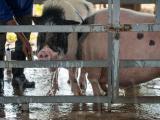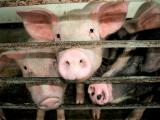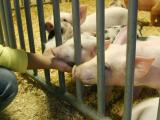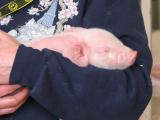Apr 30, 2009 (CIDRAP News) – To quell the notion that pigs are to blame for the swine influenza H1N1 epidemic, three international agencies said today they would take the "swine" out of the virus's name and call it "influenza A/H1N1" instead.
The United Nations Food and Agriculture Organization (FAO) said today it has agreed with the World Health Organization (WHO) and the World Organization for Animal Health (OIE) "to no longer refer to 'swine flu' but instead to 'influenza A/H1N1.'"
Joseph Domenech, the FAO's chief veterinary officer, said in the FAO statement that there is no evidence that the new virus is circulating in pigs in Mexico or anywhere else and that pork consumption poses no increased risk of contracting the virus.
The move comes in the wake of reports that Egypt began slaughtering pigs yesterday out of the mistaken concern that they could spread the new virus to people. Some countries have banned pork from Mexico and the United States for the same reason.
The US Centers for Disease Control and Prevention (CDC) also has been trying out a new name for the virus this week, but without removing "swine." In Morbidity and Mortality Weekly Report and in other documents, the CDC has been referring to the virus as "swine-origin influenza A (H1N1)."
The CDC Web page dedicated to the new virus is currently labeled "H1N1 Flu (Swine Flu)." A note on the page acknowledges inconsistencies in the name: "This is a rapidly evolving situation and current guidance and other web content may contain variations in how this new H1N1 virus of swine origin is referred to.
"Over the coming days and weeks, these inconsistencies will be addressed, but in the interests of meeting the agency's response goals, all guidance will remain posted and new guidance will continue to be issued."
A CDC spokesman who was queried about the shifting names today replied only that the name is being coordinated by the WHO.
The CDC has said the virus contains a combination of genes from North American and Eurasian swine flu strains along with avian and human flu strains. But experts quoted in Wired magazine yesterday said the virus contains genetic material only from swine flu viruses. How and where the virus made the jump to humans has not yet been determined.
In announcing the name change today, the international agencies did not explain how they would avoid confusion over the fact that one of the seasonal flu strains that circulates every year is also called influenza A/H1N1. An H1N1 strain is included in each year's flu vaccine, along with a strain of A/H3N2 and infuenza B.
Names such as H1N1 and H3N2 refer to influenza subtypes. The terms can be misleading, because two viruses of the same subtype may differ greatly in their ability to infect humans or other species. For example, the Asian variety of H5N1 avian flu virus is usually lethal to chickens and various other bird speices. But there are other viruses that are also called H5N1 that pose little danger to birds.
See also:
FAO swine flu page with statement
http://www.fao.org/news/story/en/item/19335/icode/
CDC swine influenza page
http://www.cdc.gov/swineflu/
WHO statement about the virus and the safety of pork
http://www.who.int/mediacentre/news/statements/2009/h1n1_20090430/en/index.html
Dec 30, 2005, CIDRAP News story "H5N1 avian flu viruses: What's in a name?"


















